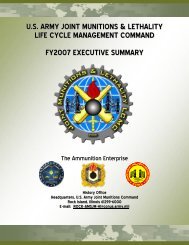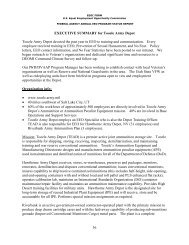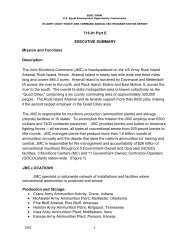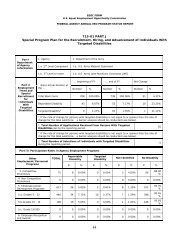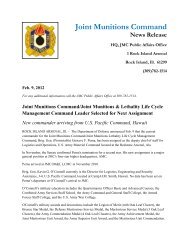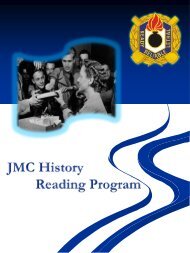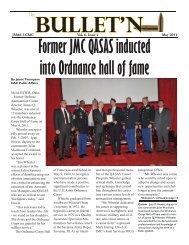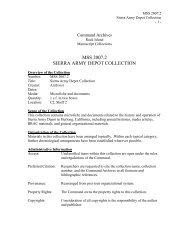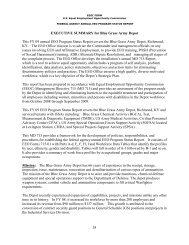History of the Ammunition Industrial Base - JMC - U.S. Army
History of the Ammunition Industrial Base - JMC - U.S. Army
History of the Ammunition Industrial Base - JMC - U.S. Army
You also want an ePaper? Increase the reach of your titles
YUMPU automatically turns print PDFs into web optimized ePapers that Google loves.
functions. Within <strong>the</strong> production base, <strong>the</strong> <strong>Army</strong> maintained ownership <strong>of</strong> propellant and<br />
explosives production while contracting with commercial sources for metal parts and fuzes. The<br />
<strong>Army</strong> <strong>the</strong>n brought all components to Load, Assemble, and Pack GOCO plants for final<br />
assembly. 131<br />
Because <strong>of</strong> shortages and <strong>the</strong> need to utilize <strong>the</strong> best aspects <strong>of</strong> <strong>the</strong> active industrial base<br />
and plants that were coming on line, <strong>the</strong> <strong>Army</strong> and Navy cooperated in <strong>the</strong> management <strong>of</strong><br />
conventional ammunition items. This cooperation worked smoothly since <strong>the</strong> <strong>Army</strong> Chief <strong>of</strong><br />
Ordnance and Navy Ordnance Bureau had cooperated in World War II. In <strong>the</strong> 1930s, primarily<br />
via <strong>the</strong> <strong>Army</strong>-Navy Munitions Board‟s procurement planning, <strong>the</strong> Services had verbally agreed<br />
which Service would procure items in an emergency. By 1941 most <strong>of</strong> <strong>the</strong>se agreements were in<br />
writing. For example, Frankford Arsenal made 5-inch projectiles, and Navy funding kept <strong>the</strong><br />
Arsenal in existence. The Navy considered interservice munitions cooperation as close as<br />
working within <strong>the</strong> Department. The relationship was especially close in <strong>the</strong> aviation arena.<br />
While <strong>the</strong> <strong>Army</strong> Air Corps (AAC) went its own way and invested significant funds in developing<br />
air-launched torpedoes which <strong>the</strong> Navy already produced (and which <strong>the</strong> AAC never used), in<br />
most o<strong>the</strong>r areas <strong>the</strong> Services worked toge<strong>the</strong>r to standardize armaments. 132 Coordination among<br />
Services became increasingly more formal. Initially loose management concepts between <strong>the</strong><br />
<strong>Army</strong> and Navy buys became tighter as DoD imposed control.<br />
With <strong>the</strong> publication <strong>of</strong> DoDD 5160.65 <strong>the</strong> SMCA became institutionalized. On 14<br />
August 1981, prior to publication <strong>of</strong> DoDD 5160.65, <strong>the</strong> Secretary <strong>of</strong> <strong>the</strong> <strong>Army</strong> had issued a<br />
SMCA Charter that delegated SMCA responsibilities to <strong>the</strong> Commanding General, Department<br />
<strong>of</strong> <strong>Army</strong> Materiel Development & Readiness Command-DARCOM (today DARCOM is <strong>the</strong><br />
<strong>Army</strong> Material Command). While many issues drove <strong>the</strong> issuance <strong>of</strong> a Charter, <strong>the</strong> most<br />
pressing was continued Congressional questions on who was <strong>the</strong> one person responsible for <strong>the</strong><br />
SMCA. The question <strong>of</strong> a single decision maker vice <strong>the</strong> committee approach <strong>of</strong> <strong>the</strong> Joint<br />
Conventional <strong>Ammunition</strong> Program (JCAP)/CG had been <strong>the</strong> major determinant in deciding to<br />
create <strong>the</strong> SMCA in 1975. In response to o<strong>the</strong>r pressures, <strong>the</strong> SMCA Charter directed<br />
DARCOM to establish a jointly staffed Executive Director for Conventional <strong>Ammunition</strong><br />
(EDCA) with <strong>of</strong>fices in <strong>the</strong> Washington DC area. The CG, DARCOM appointed <strong>the</strong> Deputy<br />
Commanding General for Readiness as <strong>the</strong> EDCA. 133<br />
In addition, to implementing <strong>the</strong> EDCA, CG, DARCOM issued a mission order that<br />
assigned execution <strong>of</strong> <strong>the</strong> SMCA mission <strong>of</strong> <strong>the</strong> Secretary <strong>of</strong> <strong>the</strong> <strong>Army</strong> to CG, ARRCOM. 134<br />
The Secretary <strong>of</strong> <strong>the</strong> <strong>Army</strong> decided to place <strong>the</strong> execution <strong>of</strong> <strong>the</strong> SMCA missions at ARRCOM<br />
level was made by <strong>the</strong> Secretary <strong>of</strong> <strong>the</strong> <strong>Army</strong> because it caused <strong>the</strong> least turbulence and least cost<br />
in manpower. 135 While ARRCOM was low in <strong>the</strong> <strong>Army</strong> hierarchy, <strong>the</strong> Secretary <strong>of</strong> <strong>the</strong> <strong>Army</strong><br />
must have assumed that creation <strong>of</strong> <strong>the</strong> EDCA would eliminate Government Accounting Office<br />
(GAO) concerns about organizational placement. The GAO recommended <strong>the</strong> SMCA report<br />
131 Logistics Management Institute, Condition and Operation <strong>of</strong> DoD <strong>Ammunition</strong> Production Facilities, Phase II,<br />
Volume I, July, 1970, 9-10. This <strong>Army</strong> arrangement is also described in o<strong>the</strong>r documents.<br />
132 For <strong>the</strong> discussion on <strong>Army</strong>-Navy Cooperation in WWII see Rowland & Boyd, 496-504.<br />
133 Statement from BG Burbules, Deputy Executive Director for Conventional <strong>Ammunition</strong>, U.S. <strong>Army</strong> Materiel<br />
Development and Readiness Command, during Defense Department Authorization and Oversight Hearings on<br />
Department <strong>of</strong> Defense Authorization <strong>of</strong> Appropriations for Fiscal Year 1984.<br />
134 DARCOM Regulation 10-71<br />
135 Statement from General Wagner during hearings before a Subcommittee <strong>of</strong> <strong>the</strong> Committee on Appropriations<br />
House <strong>of</strong> Representatives in <strong>the</strong> First Session <strong>of</strong> <strong>the</strong> Ninety-Sixth Congress.<br />
43



